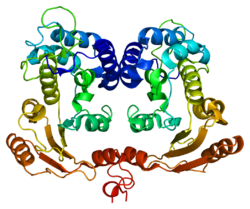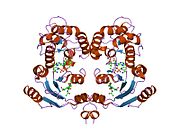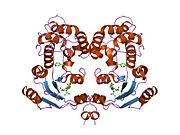BST1
| BST1 | |||||||||||||||||||||||||||||||||||||||||||||||||||
|---|---|---|---|---|---|---|---|---|---|---|---|---|---|---|---|---|---|---|---|---|---|---|---|---|---|---|---|---|---|---|---|---|---|---|---|---|---|---|---|---|---|---|---|---|---|---|---|---|---|---|---|
 | |||||||||||||||||||||||||||||||||||||||||||||||||||
| |||||||||||||||||||||||||||||||||||||||||||||||||||
| Identifiers | |||||||||||||||||||||||||||||||||||||||||||||||||||
| Aliases | BST1, CD157, bone marrow stromal cell antigen 1 | ||||||||||||||||||||||||||||||||||||||||||||||||||
| External IDs | OMIM: 600387; MGI: 105370; HomoloGene: 3198; GeneCards: BST1; OMA:BST1 - orthologs | ||||||||||||||||||||||||||||||||||||||||||||||||||
| |||||||||||||||||||||||||||||||||||||||||||||||||||
| |||||||||||||||||||||||||||||||||||||||||||||||||||
| |||||||||||||||||||||||||||||||||||||||||||||||||||
| |||||||||||||||||||||||||||||||||||||||||||||||||||
| |||||||||||||||||||||||||||||||||||||||||||||||||||
| Wikidata | |||||||||||||||||||||||||||||||||||||||||||||||||||
| |||||||||||||||||||||||||||||||||||||||||||||||||||
Bst1 (Bone marrow stromal cell antigen 1, ADP-ribosyl cyclase 2, CD157) is an enzyme that in humans is encoded by the BST1 gene.[5][6][7] CD157 is a paralog of CD38, both of which are located on chromosome 4 (4p15) in humans.[8]
Bst1 is a stromal cell line-derived glycosylphosphatidylinositol-anchored molecule that facilitates pre-B-cell growth. The deduced amino acid sequence exhibits 33% similarity with CD38. BST1 expression is enhanced in bone marrow stromal cell lines derived from patients with rheumatoid arthritis. The polyclonal B-cell abnormalities in rheumatoid arthritis may be, at least in part, attributed to BST1 overexpression in the stromal cell population.[7]
CD157 and CD38 are both members of the ADP-ribosyl cyclase family of enzymes that catalyze the formation of nicotinamide and adenosine diphosphate ribose (ADPR) or cyclic ADP-ribose (cADPR) from NAD+, although CD157 is a much weaker catalyst than CD38.[9][10][11] cADPR is required for regulation of Ca2+ in cells.[10] Only CD38 hydrolyzed cADPR to ADPR.[11] CD38 is widely expressed in tissues, whereas CD157 is primarily found in gut and lymphoid tissue.[11]
CD157 has an important role in controlling the migration of leukocytes, the adhesion of leukocytes to blood vessel walls, and the passage of leukocytes through blood vessel walls.[8]
CD157 contributes to macrophage killing of the Mycobacterium tuberculosis bacteria responsible for tuberculosis.[12]
CD157 is highly expressed in acute myeloid leukemia, and is being evaluated as a diagnostic sign, as a treatment target, and as a means of monitoring treatment progress.[13]
BST1 and BST2 genes are unregulated by the Nicotinamide (NAM) metabolism pathway.[14]
See also
References
- ^ a b c GRCh38: Ensembl release 89: ENSG00000109743 – Ensembl, May 2017
- ^ a b c GRCm38: Ensembl release 89: ENSMUSG00000029082 – Ensembl, May 2017
- ^ "Human PubMed Reference:". National Center for Biotechnology Information, U.S. National Library of Medicine.
- ^ "Mouse PubMed Reference:". National Center for Biotechnology Information, U.S. National Library of Medicine.
- ^ Ferrero E, Lo Buono N, Morone S, Parrotta R (2017). "Human canonical CD157/Bst1 is an alternatively spliced isoform masking a previously unidentified primate-specific exon included in a novel transcript". Scientific Reports. 7 (1): 159231. Bibcode:2017NatSR...715923F. doi:10.1038/s41598-017-16184-w. PMC 5698419. PMID 29162908.
- ^ Kaisho T, Ishikawa J, Oritani K, Inazawa J, Tomizawa H, Muraoka O, Ochi T, Hirano T (Jul 1994). "BST-1, a surface molecule of bone marrow stromal cell lines that facilitates pre-B-cell growth". Proc Natl Acad Sci U S A. 91 (12): 5325–9. Bibcode:1994PNAS...91.5325K. doi:10.1073/pnas.91.12.5325. PMC 43987. PMID 8202488.
- ^ a b "Entrez Gene: BST1 bone marrow stromal cell antigen 1".
- ^ a b Quarona V, Zaccarello G, Chillemi A (2013). "CD38 and CD157: a long journey from activation markers to multifunctional molecules". Cytometry Part B. 84 (4): 207–217. doi:10.1002/cyto.b.21092. hdl:2318/134656. PMID 23576305. S2CID 205732787.
- ^ Higashida H, Hashii M, Tanaka Y, Matsukawa S (2019). "CD38, CD157, and RAGE as Molecular Determinants for Social Behavior". Cells. 9 (1): 62. doi:10.3390/cells9010062. PMC 7016687. PMID 31881755.
- ^ a b Malavasi F, Deaglio S, Funaro A, Ferrero E, Horenstein AL, Ortolan E, Vaisitti T, Aydin S (2008). "Evolution and function of the ADP ribosyl cyclase/CD38 gene family in physiology and pathology". Physiological Reviews. 88 (3): 841–886. doi:10.1152/physrev.00035.2007. PMID 18626062.
- ^ a b c Rajman L, Chwalek K, Sinclair DA (2018). "Therapeutic Potential of NAD-Boosting Molecules: The In Vivo Evidence". Cell Metabolism. 27 (3): 529–547. doi:10.1016/j.cmet.2018.02.011. PMC 6342515. PMID 29514064.
- ^ Glaría E, Valled AF (2020). "Roles of CD38 in the Immune Response to Infection". Cells. 9 (1): 228. doi:10.3390/cells9010228. PMC 7017097. PMID 31963337.
- ^ Yakymiv Y, Augeri S, Fissolo G, Peola S (2019). "CD157: From Myeloid Cell Differentiation Marker to Therapeutic Target in Acute Myeloid Leukemi". Cells. 8 (12): 1580. doi:10.3390/cells8121580. PMC 6952987. PMID 31817547.
- ^ Jung J, Kim LJ, Wang X, Wu Q, Sanvoranart T, Hubert CG, Prager BC, Wallace LC, Jin X, Mack SC, Rich JN (May 2017). "Nicotinamide metabolism regulates glioblastoma stem cell maintenance". JCI Insight. 2 (10). doi:10.1172/jci.insight.90019. PMC 5436539. PMID 28515364.
External links
- Human BST1 genome location and BST1 gene details page in the UCSC Genome Browser.
- Overview of all the structural information available in the PDB for UniProt: Q10588 (Human ADP-ribosyl cyclase/cyclic ADP-ribose hydrolase 2) at the PDBe-KB.
Further reading
- Ortolan E, Vacca P, Capobianco A, et al. (2003). "CD157, the Janus of CD38 but with a unique personality". Cell Biochem. Funct. 20 (4): 309–22. doi:10.1002/cbf.978. PMID 12415565. S2CID 23453325.
- Lee BO, Ishihara K, Denno K, et al. (1996). "Elevated levels of the soluble form of bone marrow stromal cell antigen 1 in the sera of patients with severe rheumatoid arthritis". Arthritis Rheum. 39 (4): 629–37. doi:10.1002/art.1780390414. PMID 8630113.
- Kajimoto Y, Miyagawa J, Ishihara K, et al. (1996). "Pancreatic islet cells express BST-1, a CD38-like surface molecule having ADP-ribosyl cyclase activity". Biochem. Biophys. Res. Commun. 219 (3): 941–6. doi:10.1006/bbrc.1996.0327. PMID 8645283.
- Okuyama Y, Ishihara K, Kimura N, et al. (1997). "Human BST-1 expressed on myeloid cells functions as a receptor molecule". Biochem. Biophys. Res. Commun. 228 (3): 838–45. doi:10.1006/bbrc.1996.1741. PMID 8941363.
- Muraoka O, Tanaka H, Itoh M, et al. (1997). "Genomic structure of human BST-1". Immunol. Lett. 54 (1): 1–4. doi:10.1016/S0165-2478(96)02633-8. PMID 9030974.
- Wimazal F, Ghannadan M, Müller MR, et al. (2000). "Expression of homing receptors and related molecules on human mast cells and basophils: a comparative analysis using multi-color flow cytometry and toluidine blue/immunofluorescence staining techniques". Tissue Antigens. 54 (5): 499–507. doi:10.1034/j.1399-0039.1999.540507.x. PMID 10599889.
- Yamamoto-Katayama S, Sato A, Ariyoshi M, et al. (2001). "Site-directed removal of N-glycosylation sites in BST-1/CD157: effects on molecular and functional heterogeneity". Biochem. J. 357 (Pt 2): 385–92. doi:10.1042/0264-6021:3570385. PMC 1221964. PMID 11439087.
- Liang F, Qi RZ, Chang CF (2001). "Signalling of GPI-anchored CD157 via focal adhesion kinase in MCA102 fibroblasts". FEBS Lett. 506 (3): 207–10. doi:10.1016/S0014-5793(01)02912-X. PMID 11602246. S2CID 34408861.
- Yamamoto-Katayama S, Ariyoshi M, Ishihara K, et al. (2002). "Crystallographic studies on human BST-1/CD157 with ADP-ribosyl cyclase and NAD glycohydrolase activities". J. Mol. Biol. 316 (3): 711–23. doi:10.1006/jmbi.2001.5386. PMID 11866528.
- Strausberg RL, Feingold EA, Grouse LH, et al. (2003). "Generation and initial analysis of more than 15,000 full-length human and mouse cDNA sequences". Proc. Natl. Acad. Sci. U.S.A. 99 (26): 16899–903. Bibcode:2002PNAS...9916899M. doi:10.1073/pnas.242603899. PMC 139241. PMID 12477932.
- Funaro A, Ortolan E, Ferranti B, et al. (2005). "CD157 is an important mediator of neutrophil adhesion and migration". Blood. 104 (13): 4269–78. doi:10.1182/blood-2004-06-2129. PMID 15328157. S2CID 12053010.
- Gerhard DS, Wagner L, Feingold EA, et al. (2004). "The status, quality, and expansion of the NIH full-length cDNA project: the Mammalian Gene Collection (MGC)". Genome Res. 14 (10B): 2121–7. doi:10.1101/gr.2596504. PMC 528928. PMID 15489334.
- Hillier LW, Graves TA, Fulton RS, et al. (2005). "Generation and annotation of the DNA sequences of human chromosomes 2 and 4". Nature. 434 (7034): 724–31. Bibcode:2005Natur.434..724H. doi:10.1038/nature03466. PMID 15815621.
- Liu T, Qian WJ, Gritsenko MA, et al. (2006). "Human plasma N-glycoproteome analysis by immunoaffinity subtraction, hydrazide chemistry, and mass spectrometry". J. Proteome Res. 4 (6): 2070–80. doi:10.1021/pr0502065. PMC 1850943. PMID 16335952.
- v
- t
- e
-
 1isf: Crystal Structure Analysis of BST-1/CD157
1isf: Crystal Structure Analysis of BST-1/CD157 -
 1isg: Crystal Structure Analysis of BST-1/CD157 with ATPgammaS
1isg: Crystal Structure Analysis of BST-1/CD157 with ATPgammaS -
 1ish: Crystal Structure Analysis of BST-1/CD157 complexed with ethenoNADP
1ish: Crystal Structure Analysis of BST-1/CD157 complexed with ethenoNADP -
 1isi: Crystal Structure Analysis of BST-1/CD157 complexed with ethenoNAD
1isi: Crystal Structure Analysis of BST-1/CD157 complexed with ethenoNAD -
 1isj: Crystal Structure Analysis of BST-1/CD157 complexed with NMN
1isj: Crystal Structure Analysis of BST-1/CD157 complexed with NMN -
 1ism: Crystal Structure Analysis of BST-1/CD157 complexed with nicotinamide
1ism: Crystal Structure Analysis of BST-1/CD157 complexed with nicotinamide
This article incorporates text from the United States National Library of Medicine, which is in the public domain.
 | This membrane protein–related article is a stub. You can help Wikipedia by expanding it. |
- v
- t
- e
























